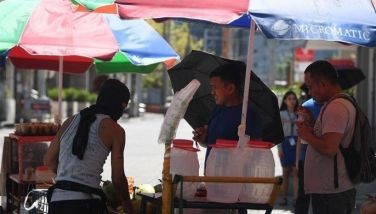Climate change made April heat in Asia hotter, more likely — scientists

Heatwave threat in Philippines to rise as climate change worsens
MANILA, Philippines — Extreme temperatures that gripped Asia, including the Philippines, in April were made worse and more likely by human-caused climate change, according to an analysis by climate scientists.
Exceptionally hot weather across Asia triggered health warnings, forced thousands of schools to close down, killed hundreds of people, and damaged crops.
“From Gaza to Delhi to Manila, people suffered and died when April temperatures soared in Asia,” said Friederike Otto, senior lecturer at the Grantham Institute-Climate Change and the Environment in the Imperial College London and co-author of the study by the World Weather Attribution group.
“Heatwaves have always happened. But the additional heat, driven by emissions from oil, gas and coal, is resulting in death for many people,” Otto added.
Through published peer-reviewed methods, scientists analyzed the impact of climate change on the intensity of the three-day April heatwave in West Asia and a 15-day heatwave in the Philippines.
The scientists found that in the Philippines, similar heatwaves are expected to happen about once every 10 years during El Niño conditions and about once every 20 years in other years without the influence of El Niño.
They also said that a heatwave of this intensity would have been virtually impossible in the Philippines without human-caused climate change, even under El Niño conditions.
“Overall, climate change made this year’s heatwave 1°C hotter, while El Niño made the heatwave a further 0.2°C hotter. If global warming reaches 2°C, similar heatwaves in the Philippines will occur every two to three years and will become another 0.7°C hotter,” the study said.
In the Philippines, exceptionally hot weather prompted schools to shift classes online and threatened power grids. At least seven people have died from heat-related illnesses since the start of the year, according to the Department of Health.
Heat planning
The researchers said the increasing risk of dangerous heat, particularly in rapidly growing cities like Manila, highlights the critical need for heat planning that protects vulnerable communities.
“Heat action plans set out measures for dealing with heat, like changing work and school hours,” said Carolina Pereira Marghidan, a climate risk consultant at the Red Cross Red Crescent Climate Centre.
“Although various countries have made substantial progress on such plans, there is an urgent need to scale up and further strengthen them across Asia to deal with the rising heat,” she added.
The Department of Education is gradually reverting back to the academic calendar year, when classes begin in June and end in March.
Meanwhile, labor groups like Kilusang Mayo Uno are calling on the government and employers to establish measures to ensure the safety of workers such as extended breaks, noting that extreme heat is a “health and safety hazard.”
The World Weather Attribution study was conducted by 13 researchers, including scientists from universities and meteorological agencies in Malaysia, Sweden, the Netherlands, and the United Kingdom.
- Latest



























